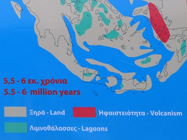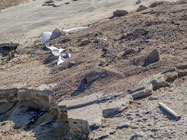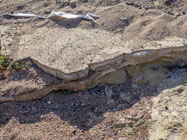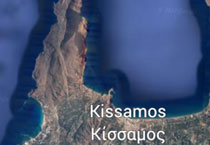|
||||||||||||
|
Page 1/5 (this page)
|
Looking for the northern ape-man webpage 1/5
Text, photography: Annemieke van Roekel, geoscience journalist
The prints, found in a thin layer (a few cm) of sandstone, are now covered with a water-repellent
cloth and gravel on top; a fence has been placed around the site. An information board along the
road (fig. 1 and 2: detail) shows an enlarged view of the trace fossils and a paleogeographical map of north-western
Crete during the late Miocene, showing that this area was connected to the Greek mainland (the Peloponnese),
while the middle and eastern part of 'Crete' was made up of a few islands. 

of Trachilos in the evening sun. Photo: A. van Roekel. Fig. 2. Detail with paleomap (Late-Messinian). Theft in 2017 Unfortunately, due to the cover with cloth and gravel (fig. 3 left and right), the visitor does not get to see much. The fact that the tracks were covered goes back to a theft in 2017. Immediately after the tracks became known, a local seized his chance and removed part of the layer, a thin 'plate', which, judging by the remainder, was simply ripped off if you stick a big knife between them. He tried to sell the loot in Thessaloniki, but was caught. The stolen 'footsteps' were finally recovered and are now safely stored in the basement of a museum in Crete. I suspect that the remaining - in situ - part, near the beach, is inundated by waves a few times a year, but then it has to storm really hard, given the distance to the waterline, around five meters, and the height above sea level. 

degrees) and is only a few cm thick. Photo: A. van Roekel. More fossils in the surroundings of Trachilos The second time I visited the site in 2021 (the first on October 11th; the second on November 3rd, hoping that the covering would be removed) I met the archaeologist looking after the site, Ioannis Papadakis. Near Trachilos, he is engaged in archaeological excavations. The area is rich in special fossils, he told me. Fossil traces of a feline with tusks have been found nearby and the fossil skeleton of a dolphin (now in a museum) was found in the adjacent Gramvousa Peninsula, immediately west of Trachilos. Further east, 10 km from Trachilos, near the town of Voúves, detailed footprints of a hyena-like species (Iliopoulos et al., 2012) have been found in Late Miocene lacustrine sediments. These were the first trace fossils found in Crete at the time. Page 1/5 (this page) Page 2/5 Page 3/5 Page 4/5 Page 5/5 Top photo: Google Earth. Last update: April 16, 2022 |
|||||||||||
